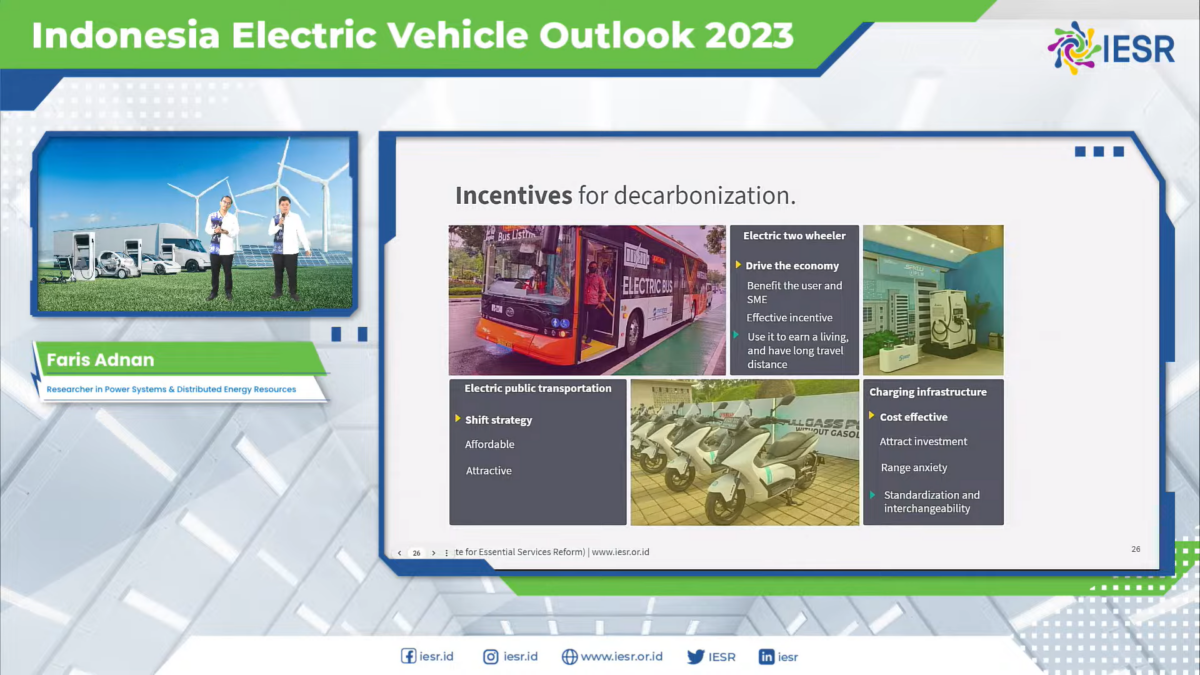Jakarta, 21 February 2023 – The transportation sector contributes almost a quarter of the energy sector’s emissions in 2021. Most of the transportation sector’s emissions come from fuel, of which 52% comes from imported fuel. Given the Indonesian government’s target of achieving net-zero emission status by 2060 or sooner, it is important to decarbonize the transportation sector.
Adapting the ASI approach, i.e: Avoid – Shift – Improve, the Institute for Essential Services Reform (IESR) is looking at one of the decarbonization strategies for the transportation sector, namely electric vehicles. Explained by Fabby Tumiwa, Executive Director of IESR during the launch report of the Indonesia Electric Vehicle Outlook 2023, that the number of electric vehicles in Indonesia has continued to increase in the last 5 years, but the market share is still low.
“However, the electric vehicle market share is only 1% of total vehicle sales in Indonesia per year. Several factors still make potential buyers reluctant, such as the high initial price, and supporting ecosystems such as charging stations which are still limited in number,” he explained.
As one of the supporting ecosystems for electric vehicles, charging stations, both Public Charging Stations (SPKLU) and Public Battery Swapping Stations (SPBKLU) have an important role in accelerating the adoption of electric vehicles. Psychologically, the number of charging stations influences the decision of potential EV consumers.
“In numbers, the number of SPKLUs actually continues to grow. But currently it is still concentrated in Java and Bali. Only 12% of SPKLU are located outside Java – Bali,” explained Faris Adnan, IESR Power System researcher.
In addition to the number of charging stations, Faris stated a few more things, including the type of charging system, which currently most of the SPKLU is slow charging type one. It is necessary to look for a comprehensive location to determine the type of charging used. Office areas and shopping centers where people will stay around can use medium or slow charging. However, for places such as public charging on roads, it must use the fast-charging type.
Standardization of charging ports is also one of the discussions in this report. Faris explained that currently there are 3 types of charging ports for four-wheeled electric vehicles. This is one of the obstacles for prospective SPKLU investors because the obligation to provide these three types of ports has an impact on the investment capital that must be provided.
“If the government manages to standardize port charging, the investment value for SPKLU will be more attractive,” explained Faris.
Ilham Fahreza Surya, IESR environmental policy researcher, who is also the author of IEVO 2023 added that the government’s discourse to provide price incentives for electric vehicles should focus specifically on public transportation, logistics vehicles, and two-wheeled vehicles.
“We recommend that the government give priority to two-wheeled vehicles to get incentives to cut prices, and also combine this incentive plan with TKDN rules. So those who are entitled to receive incentives are motorbikes that come from manufacturers who have complied with TKDN regulations,” explained Ilham.
From an industrial standpoint, electric vehicle assembly is the most advanced industry compared to the other supporting electric vehicles component industry. One of the highlights is Indonesia’s plan to downstream nickel into batteries.
Pintoko Aji, IESR’s renewable energy researcher, sees that the Indonesian government’s plan can be utilized by the electric vehicle industry that intends to operate a factory in Indonesia.
“With the existence of a domestic battery industry, domestic electric vehicle manufacturers can use domestically produced batteries in their vehicles as a strategy for fulfilling TKDN components,” explained Pintoko.
In a panel discussion following the presentation of the Indonesia Energy Transition Outlook 2023 report, Wildan Fujiansah, Coordinator of Electricity Technical Feasibility, the Ministry of Energy and Mineral Resources explained that, to answer several issues in the provision of electric vehicle ecosystems in Indonesia, they issued a MEMR ministerial regulation No.1/2023 which regulates one of them regarding standardization charging port, power and battery size.
“Ministerial Regulation No. 1/2023 also regulates SPKLU investment, which previously had to provide 3 charging ports, now only 1 is enough. One of the objectives of this regulation is indeed to boost SPKLU investment,” explained Wildan.
Riza, Senior Researcher for Electric Vehicle Charging Infrastructure, BRIN stated that from a technical point of view the electric vehicle charging process is not just a device with a certain technology.
“In its development, the charging process must match the battery features while the EV continues to develop, “said Riza.
From the user side, two-wheeled electric vehicles are currently widely used by ride hailing companies for their driver partners. However, to increase the confidence of potential users to switch to using electric vehicles, the number of supporting infrastructure, especially battery swapping stations, needs to be increased.
Rivana Mezaya, Director of Digital and Sustainability Grab Indonesia emphasized that from an industrial point of view, electric vehicle users can explore various efforts to own electric vehicle units, but support is needed regarding the availability of supporting infrastructure such as battery swapping stations.
“This collaboration with various parties will encourage the general public to be able to take part in the energy transition in Indonesia,” said Meza.
In addition to collaboration to create an ecosystem that supports electric vehicles from upstream to downstream, dissemination of comprehensive, easily accessible and discoverable information is very important to encourage changes in people’s behavior. This was said by Indira Darmoyono, Chairperson of the Environmental and Energy Transportation Forum, Indonesian Transportation Society.
“Good practices in using electric vehicles and important information such as where conversion workshops are certified, conversion costs, incentives in various forms must be widely publicized so that people have sufficient information and are motivated to switch to electric vehicles,” concluded Indira.
The Indonesia Electric Vehicle Outlook report is one of the main IESR reports, and can be read through https://iesr.or.id/pustaka/indonesia-electric-vehicle-outlook-ievo-2023

